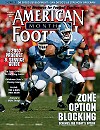AMERICAN FOOTBALL MONTHLY THE #1 RESOURCE FOR FOOTBALL COACHES
Article CategoriesAFM Magazine
|
Synthetic Turf: Wave of the Future© More from this issueChances are very good that your team has either a) played at least one road game on a synthetic turf field or b) installed a synthetic turf field at your home facility. If neither applies to your program, expect that to change in the near future. • The “New Generation” synthetic turf fields, once considered a luxury only NFL teams or high-profile universities could afford, are being installed at high schools and colleges from Maine to California. The trend is so strong that industry leaders expect that within 10 years well over half of all football games played in the U.S. will be played on an artificial surface. • What’s driving this trend? Certainly the products have improved since the days of the oft-maligned original carpet-style turf of the 60’s and 70’s. Costs have come down as well. Yet, at $500,000+ for a new installation, these f....The full article can only be seen by subscribers. Subscribe today!
|
|
|||||||
| HOME |
MAGAZINE |
SUBSCRIBE | ONLINE COLUMNISTS | COACHING VIDEOS |
Copyright 2025, AmericanFootballMonthly.com
All Rights Reserved





